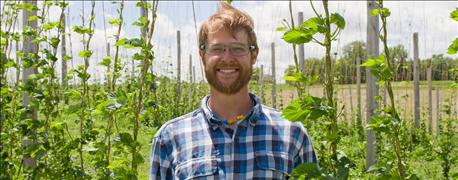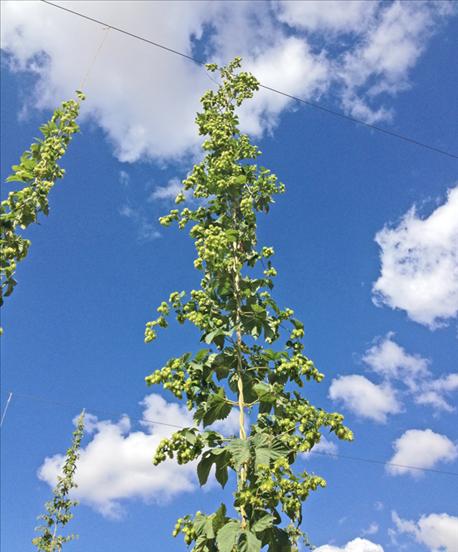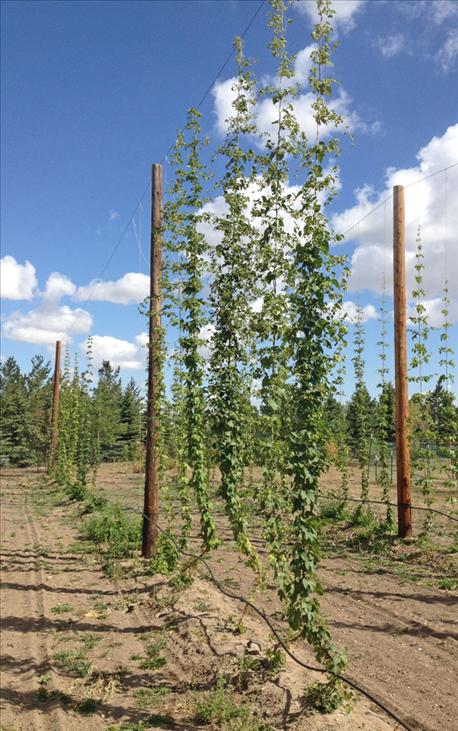October 3, 2016

Lee Anderson is not a typical farmer in southeastern South Dakota.
He does not grow corn or soybeans on the land that’s been in his family for four generations. Others rent the land for that purpose. Instead, he uses 6 acres on an 80-acre parcel to grow hops.
Anderson, 30, grew up in Sioux Falls and graduated from Lincoln High School. His family’s land south of Valley Springs, S.D., has been in the family since his grandfather homesteaded it in 1882.
Anderson started thinking about growing hops in 2007 when he and his brother, Josh, kicked around the idea. Anderson planted his first hops in 2012. He and his wife, Nelleigh, run the hop farm with occasional help from his mom and brother.

STARTUP: Lee Anderson started a hops yard on his farm near Sioux Falls, S.D.
Getting the hop farm started and handling the permitting process to have a brewery/distillery has been an undertaking.
“This is so unconventional to corn and beans. You have to do a lot of research and a lot of talking to people,” he says.
Anderson has traveled to Colorado and Oregon to visit hop farms and bought his Wolf Picker 140 harvester from Glen Fuller in Hotchkiss, Colo. His harvester was built in 1972 and was shipped to the United States from Poland — in pieces.
Anderson wanted his hops farm to be zoned agricultural tourism, but the state required a certain number of pounds grown on the property before that designation could be given. In 2012, he produced 59 pounds on 2 acres in a drought year. Last year, he produced 1,500 pounds on 6 acres.

SKY HIGH: Hops climb trellises and grow about 20 feet tall.
With that amount produced, Anderson Hop Farm and its brewing company — A Homestead Brew — applied for the agricultural tourism permit. With that permit in mind, Anderson started building a facility on his hops farm that will include a taproom, brewery, a view of the farm and the processing side. He is permitted to have up to 300 people on the property for weddings, corporate events and other events.
For his taproom, they took the siding from the house his grandfather was born in, scraped it, sprayed it for bugs and reinstalled it behind the tall bar.
Growing process
Anderson grows several varieties of hops. He started out in 2012 with Chinook and Nugget. The next year he planted Perle and Centennial. He has added Cascade and another section of Chinook. Since they are perennials, they will come back yearly, but the plants take a lot of care.
“It’s a lot to take care of the plants, add more poles and plant more plants. It’s just a lot going on,” he says.

POLE PLANTING: Telephone poles support trellises.
To plant a row of hops, Anderson drives in tall poles and strings a wire across the top. Then once the plants start growing, he strings twine from the top wire to the ground for the hops to start growing up. He helps the plants to start climbing by twisting their vines clockwise around the twine.
Anderson planted Dutch white clover in the hops yard to help replenish nitrogen and choke out the weeds. Weeds, lack of nutrients and bugs are all troublemakers for hops.
“Weeds are a big issue. Nutrient deficiency is always something you’re going to have to battle,” he says. “Bugs are something you’ll always have to battle.”
For the weeds, the clover helps some, but he does a lot of weed whacking. To help the plants get the most nutrients, he prunes the extra little shoots that come up to keep them from robbing the main plant of energy.
Harvesttime
Anderson harvests his hops at the end of August or the first few weeks of September. They are in their fourth year using the Wolf Picker 140. The machine takes a plant every 30 seconds.
They use a tractor with a platform on it to reach up and cut down the twine. Then, they run the vines through the harvester, which gets all the cones off. The cones go into their three-tier dry floor.
Once dried, they are put into bales and into the cooler. About five weeks later, those can be pelletized.
Anderson just got his 10-barrel fermenters, brew kettles and mash tubs delivered this summer. Once those are fully installed, he will be able to brew 620 gallons a week.
Hops market
Anderson says small breweries are popping up all over South Dakota, and they are going to need hops from somewhere.
“Sourcing something locally, there’s a green footprint we’re looking at. With a local product, you know where it’s coming from,” he says.
Currently, hops from Anderson Hop Farm go to Crow Peak Brewing in Spearfish, S.D., to be used in their Canyon Cream Ale and other brews.
Anderson sees a future for hops farms in South Dakota.
“I see a lot of room for other new farmers to get into it. The amount of breweries that are popping up around here, it’s got to come from somewhere,” he said.
And, those hops might as well come from South Dakota.
Sweeter writes from Worthing, S.D.

FROM POLAND: The Wolf Picker 400 is a Polish hops thresher than removes the cones from the vines.

MATURE HOPS: Hops cones are ready for harvest in August and September.

CLOSE UP: Lee Anderson splits open a hops cone.

BALING HOPS: Hops are baled for market.
You May Also Like




